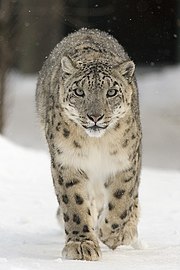Altai-Sayan region
The Altai-Sayan region is an area of
The area is also culturally diverse, with four language groups (Russian, Mongolian, Sinitic and Turkic, formerly Samoyedic and Yeniseian as well) and more than 20 indigenous ethnic groups practicing traditional land use systems. There are also a variety of religions including Christianity, Islam, Buddhism, Tengrism and Shamanism. The region covers more than one million square kilometers, and has a population of between 5 and 6 million inhabitants.[1]
Geography

The Altai-Sayan
The Altai-Sayan has a total area of 1,065,000 square kilometers. Its area belongs to the territory of Russia (62%), Mongolia (29%), Kazakhstan (5%) and China (4%).[2]: 233
Part or all of the Russian
At the far north of the Altai-Sayan region, near its boundary, is the Russian city of Krasnoyarsk (population above 900,000 in 2010 census).[2]: 233 Other towns in the region include Kyzyl in Russia (pop. about 110,000 in 2008), as well as Ulaangom, Ulgii, and Khovd, all in Mongolia (each with population under 30,000).[2]: 233 The Russian town of Gorno-Altaysk (pop. about 60,000 in 2010) lies within the region near its western boundary, and the Russian city of Irkutsk lies just outside the region to its east.[2]: 233 The Altai-Sayan region's total population is estimated as about 5.5 million.[2]
Contained within this ecoregion is the
Cultural history
According to Anatoliy Mandych, a geographer at the
For many centuries, the region has been at the crossroads of European and Asian civilizations, and thus is home to great historical treasures. The ancient history of the region is so unique that many historians and archaeologists call it “the cradle of civilization”. The ancient historic monuments are integrated into the natural landscape in such a way that it forms a harmonious and inseparable unity. Thousands of
tumuli and other ancient monuments are found in the area, some even as ancient as the Egyptian pyramids.[2]: 235–6
Anthropology

Altai-Sayan is home to the
Recent genetic studies have shown that some indigenous peoples of the Americas are partially derived from southern Altaians.[8]
Ecology and preservation

According to the
There are three major
The
The World Wildlife Fund has conducted studies of the region.[2] It has identified the Altai-Sayan ecoregion as a priority region for wildlife conservation.[12] According to the World Wildlife Fund, "The Altai-Sayan ecoregion is one of the last remaining untouched areas of the world."[12] Furthermore:
680 species of the vertebrates are registered in the Ecoregion. Among them: 77 species of fishes, 8 species of amphibians, 25 species of reptiles, 425 species of birds and 143 species of mammals.[12]
Threats to the biodiversity of the region, according to the Fund, include poaching and illegal wildlife trade, industrial development, climate change, overgrazing and competition for pastures, unsustainable forestry, water pollution, and poverty.[12]
Beginning in the late 1990s, several government-level initiatives were begun with the stated purpose that included helping to preserve the Altai-Sayan ecoregion and biodiversity. In 1998, representatives of Kazakhstan, China, Mongolia and Russia met in
organizations representing state governments of
Eastern Kazakhstan Region (Kazakhstan), the Republic of Altai (Russia), Xinjiang Uygur Autonomous Region (China) and Khovd Aimag (Mongolia) resolved to establish an International Steering Board called "Altai, Our Common Home"[2]: 238
However, as of 2010, the steering organization "Altai, Our Common Home" had played a coordinating role "less in conservation and ecological themes" than in "economic and cultural exchange programmes".[13]: 250 Analysts stated that "while the [ecosystem conservation] soil has been prepared for cultivation rather well", after 10 years "there are no tangible results yet".[13]: 250 They expressed concern that
At the 'grass roots' level, managers of transboundary protected areas were not involved in the process. The leading role was played by international
NGOs and funders. Overall, the general concept was not clearly formulated and developed.[13]: 250
The Altai-Sayan region is the northernmost habitat of the
Science and scholarship
The Altai-Sayan region, or phenomena associated with it, have been the focus of various types of science and scholarship in diverse fields:
- Geneticists speak of the Altai-Sayan region when referring to certain human populations from that region.[14]
- Geologists describe the Altai-Sayan region as the site of a Paleo-Asian ocean.[8]
- Historians refer to the Altai-Sayan peoples.[15]
See also
References
- ^ "Millennium Ecosystem Assessment". Archived from the original on 2014-03-28. Retrieved 2014-03-28.
- ^ ISBN 1-4020-4491-7.
- ^ "Great Lakes Depression", Great Soviet Encyclopedia
- ^ Dutch, Steve; Pleistocene Glaciers and Geography Archived 2014-02-06 at the Wayback Machine, Natural and Applied Sciences, University of Wisconsin-Green Bay (accessed 30 November 2006)
- ^ World Wildlife Fund, webpage describing the Altai-Sayan Montane Forests Archived 2016-06-30 at the Wayback Machine (accessed 25 January 2014)
- PMID 21868646. Archived from the original(PDF) on 2013-07-09. Retrieved 2014-03-28.
- S2CID 22038385.
- ^ S2CID 128751598.
- ^ . Retrieved 12 November 2021.
- ^ Barras, Collin (2014); '"Ice-age animals live on in Eurasian mountain range", New Scientist (accessed 24 January 2014)
- ^ "Freshwater Issues in Mongolia"
- ^ a b c d World Wildlife Fund, Altai-Sayan Mountains (accessed 25 January 2014)
- ^ ISBN 978-1844076048.
- S2CID 23011845.
- ISBN 9780521477710(p. 276)
External links
- Map of Altai-Sayan region at World Wildlife Fund
- Altai-Sayan ecoregion at United Nations Environmental Programme
- Altai-sayan.com (United Nations Development Programme)
